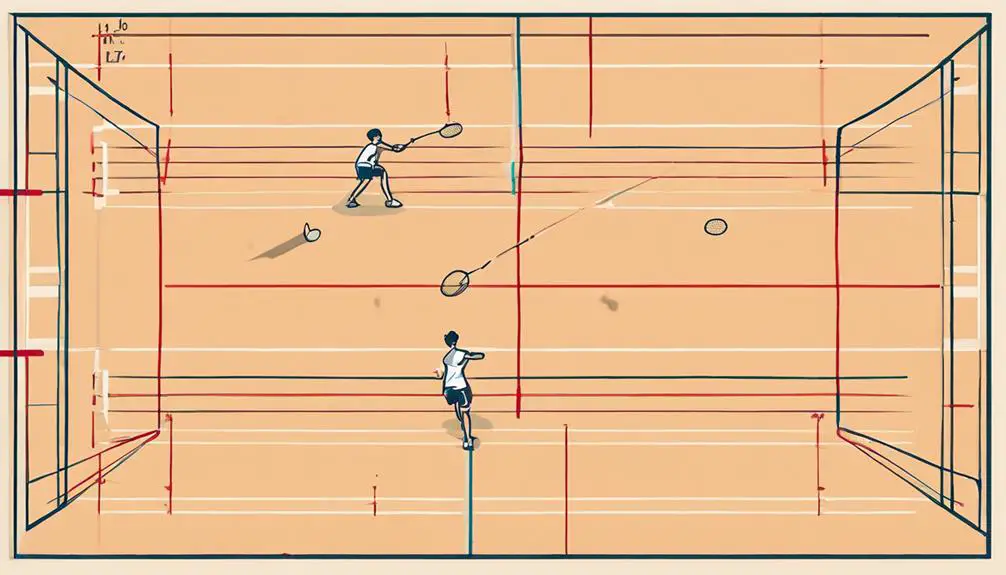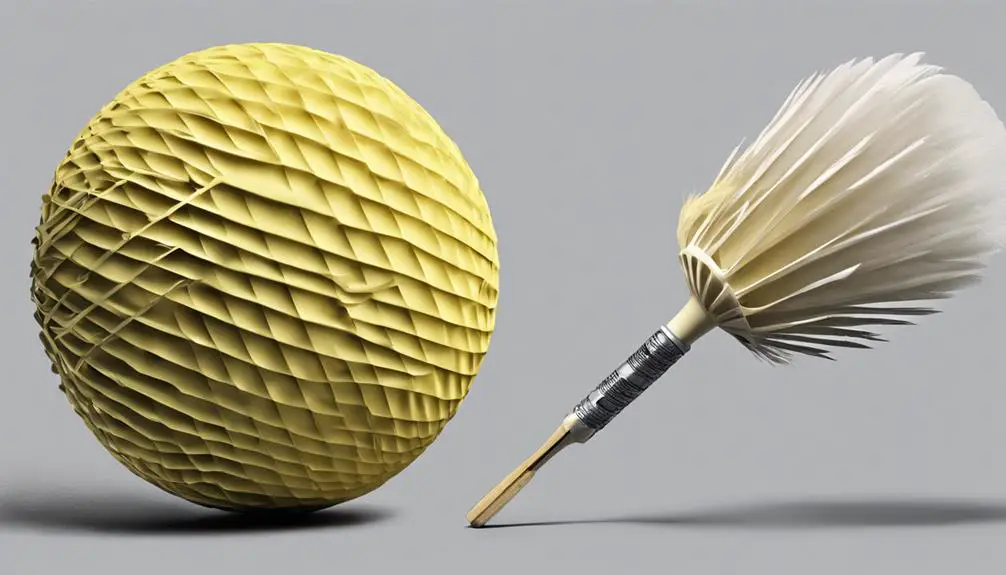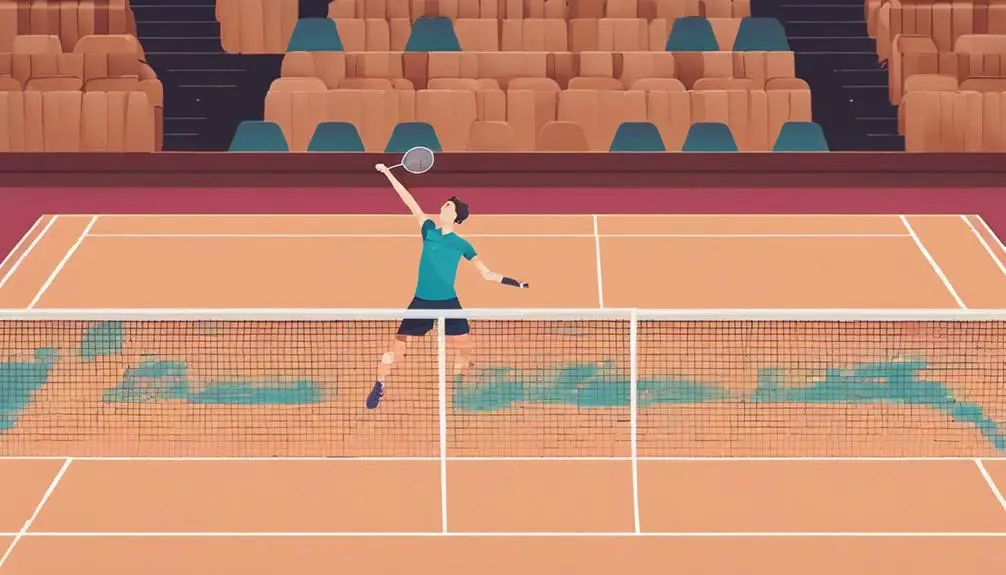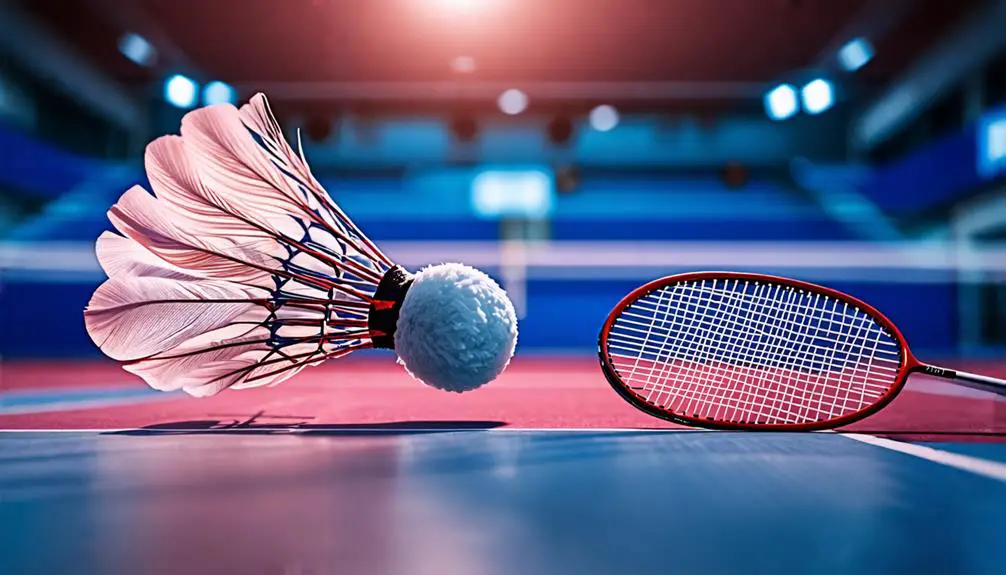You're likely confusing the terms "shuttlecock" and "badminton," which are often used interchangeably, but actually refer to distinct concepts. A shuttlecock is the projectile used in badminton, a racquet sport played with a rally scoring system. Badminton is the sport itself, which involves hitting the shuttlecock over a net in a defined rectangular court. While shuttlecocks can be made from feathers or synthetic materials, badminton games are typically played to 21 points. Understanding the difference between these two terms will give you a clearer picture of the sport, and its intricacies will become apparent as you explore further.
Badminton and Shuttlecock Definitions

Although often used interchangeably, the terms "badminton" and "shuttlecock" refer to distinct aspects of the sport. You'll find that badminton is a racquet sport where players aim to hit a shuttlecock over a net into the opponent's court, scoring points when the shuttlecock lands in the designated area. On the other hand, a shuttlecock, also known as a "birdie," is the projectile used in badminton, typically crafted from feathers or plastic materials attached to a cork base.
Understanding the definitions of these terms is essential for grasping the game's dynamics. You see, badminton is a sport with a structured scoring system, where matches are played to 21 points. In contrast, the term "shuttlecock" solely refers to the equipment used in the game, without any direct relation to the scoring system or court dimensions. Speaking of court dimensions, a badminton court is 13.4 meters long and 6.1 meters wide for doubles play, whereas shuttlecock games can be played in informal settings without specific court sizes.
The distinction between badminton and shuttlecock becomes clearer when examining the construction of shuttlecocks. You'll notice that feather shuttlecocks are favored in professional play for their flight characteristics, while nylon shuttlecocks are more commonly used for casual and recreational play. By recognizing the unique aspects of badminton and shuttlecock, you'll gain a deeper understanding of the sport and its intricacies. This knowledge will ultimately enhance your appreciation for the game, whether you're a seasoned player or an enthusiastic spectator.
Equipment Used in Badminton
Badminton gear encompasses a range of specialized equipment, with the racquet being a vital component that greatly impacts a player's performance. When choosing a racquet for badminton, you'll find that most are lightweight, typically weighing between 70-100 grams. They're made from materials such as carbon fiber or aluminum, which allow for enhanced maneuverability and strength. This specialized design enables you to move quickly and strike the shuttlecock with precision, a significant aspect of the shuttlecock vs badminton dynamic.
The shuttlecock itself is another key piece of equipment. You have two main types to choose from: feather shuttlecocks, favored in professional play for their ideal flight characteristics, and nylon shuttlecocks, which are more durable and commonly used for recreational play. Both are suited to the speed and agility required when badminton is played.
The badminton court and its markings are also important considerations. The standard net height is 1.55 meters at the center, defining the boundary for the shuttlecock. Court markings differ for singles and doubles play, with designated service areas determining where you must serve and receive the shuttlecock.
Lastly, your choice of footwear can affect your performance. Non-marking shoes designed specifically for badminton provide ideal traction, preventing damage to the court surface and allowing you to move freely and rapidly around the court. By selecting the right equipment, you'll be well-prepared for the fast-paced action of badminton.
Gameplay Rules and Structure

Within the fast-paced world of shuttlecock vs badminton, understanding the gameplay rules and structure is essential for success. As you step onto the court, you'll need to grasp the rally scoring system, where players score points on every serve, with games typically played to 21 points.
You'll be playing on a court that measures 13.4 meters long and 6.1 meters wide for doubles play, with the net standing at 1.55 meters high in the center. To serve, you must do so underhand, striking the shuttle below waist height. A match consists of the best of three games, with players switching sides after each game and when one player reaches 11 points in the final game.
Some key things to watch out for include:
- Hitting the shuttlecock out of bounds
- Failing to clear the net
- Committing a foot fault during the serve
You'll want to avoid these common faults to up your badminton game. Each game is a fresh chance to adapt your strategy and outmaneuver your opponent. As you navigate the fast-paced world of badminton, understanding these gameplay rules and structure will be your key to success. With practice and dedication, you'll be a pro at serving, volleying, and smashing the shuttle in no time. Whether you're a seasoned player or just starting out, mastering the rules of badminton is essential to enjoying the game and improving your skills.
History and Popularity of Badminton
You're about to explore the rich history and widespread popularity of badminton, starting with its origins in 19th-century British India, where it evolved from traditional games involving shuttlecocks. As you examine the sport's rise to global fame, you'll notice the pivotal role of the 1992 Olympics, which catapulted badminton onto the world stage, and the formation of the Badminton World Federation, which governs international competitions. Through this journey, you'll gain insight into how badminton has become one of the most played sports worldwide, with a massive following in countries like China, Indonesia, and Denmark.
Origins of the Sport
Emerging from the mid-19th century in British India, the sport we recognize today as badminton has its roots in earlier games that utilized shuttlecocks, which were played by British expatriates and the local elite. You'll find that the game of badminton was officially named after Badminton House in Gloucestershire, England, where it was first introduced to British society.
Some key facts about the origins of badminton include:
- The sport evolved from earlier games involving shuttlecocks, with the modern version emerging in British India.
- The name "badminton" comes from Badminton House, where the game was first played in England.
- The shuttle is played with a racquet, and its unique flight pattern requires quick reflexes and strategy to hit.
As you explore the history of badminton, you'll notice that the sport gained popularity in the mid-19th century, particularly among the British upper class. The establishment of the Badminton World Federation (BWF) in 1934 marked a significant milestone in the sport's development, paving the way for international competitions and governance. Today, badminton is enjoyed globally, with top players and teams hailing from countries like China, Indonesia, and Denmark.
Rise to Global Fame
As one explores the history of badminton, it becomes apparent that the sport's rise to global fame was a gradual process, spanning over a century. You'll discover that badminton originated in British India in the mid-19th century, evolving from the older game of battledore and shuttlecock. The sport's popularity grew steadily, but it wasn't until 1992, when badminton gained official recognition as an Olympic event, that its global profile considerably increased.
You'll notice that the establishment of the Badminton World Federation (BWF) in 1934 played a vital role in expanding the sport's reach worldwide. Today, badminton is one of the most played sports globally, with countries like China, Indonesia, and Denmark producing numerous elite players. Major tournaments, such as the All England Open and BWF World Championships, attract large audiences and showcase the sport's competitive level. As you investigate deeper, you'll see that the shuttle has become an iconic symbol of the sport, synonymous with badminton's speed, agility, and skill. With its rich history and growing popularity, badminton has solidified its place as a beloved sport around the world.
Governing Body Formation
The establishment of the Badminton World Federation (BWF) in 1934 marked a pivotal moment in the sport's history, solidifying its position as a globally recognized and regulated activity. You see, the BWF's governing body formation played an essential role in standardizing the rules and regulations of badminton competitions worldwide. This, in turn, paved the way for the sport's inclusion in the Olympic Games in 1992, greatly boosting its global popularity and participation rates.
Some key aspects of the BWF's impact on badminton include:
- The standardization of equipment, including the iconic shuttlecock, to guarantee consistency and fairness in competitions.
- The creation of a ranking system, allowing players to track their progress and compete against others at similar levels.
- The organization of major tournaments, such as the All England Open and BWF World Championships, which attract top players and contribute to the sport's visibility and growth on a global scale.
Through its governing body formation, the BWF has enabled badminton to evolve from a casual pastime into a highly organized and competitive activity, enjoyed by millions worldwide. As a result, badminton has become one of the most played sports internationally, with a considerable following in countries like China, Indonesia, and Denmark.
Health Benefits and Cultural Impact

You'll discover that badminton offers numerous physical and mental benefits, including enhanced cardiovascular fitness, improved muscle strength, and boosted hand-eye coordination. As you engage in the sport, you'll also experience social benefits, such as community engagement and teamwork, which are fostered through recreational play and tournaments. By examining the cultural significance of badminton, you'll gain insight into its role in shaping regional identity and promoting national pride in countries where it is a beloved sport.
Physical and Mental Benefits
Regularly playing badminton can have a profound impact on one's physical and mental wellbeing. As you engage in this fast-paced sport, you'll experience numerous benefits that enhance your overall health and fitness.
When you play badminton, you'll burn between 400-600 calories per hour, making it an effective workout for weight management and overall fitness. Here are just a few ways badminton can benefit your physical and mental health:
- Improved cardiovascular health: Badminton enhances cardiovascular health by engaging the heart and lungs through dynamic movements and quick bursts of activity.
- Increased coordination and reflexes: The sport improves coordination and reflexes as players must quickly respond to the shuttlecock's trajectory and speed during gameplay.
- Improved muscle strength: Regular participation in badminton can lead to improved muscle strength, particularly in the legs, arms, and core, due to its fast-paced and agile nature.
As you continue to play badminton, you'll experience these benefits firsthand. The physical and mental demands of the sport will challenge you, but the rewards will be worth it – a stronger, healthier, and more agile you.
Social and Cultural Significance
Beyond its physical and mental benefits, badminton's impact extends into the sphere of social and cultural significance, weaving a complex tapestry of community engagement, national pride, and casual recreation. As you investigate the world of badminton, you'll discover that it fosters social interaction on a global scale. Clubs and associations unite players of all skill levels, creating a sense of belonging and camaraderie. This social aspect is particularly evident in countries like Indonesia and China, where badminton is elevated to a national sport, reflecting its massive popularity and community pride.
The cultural significance of badminton varies globally, but its impact on promoting physical health and social interaction is undeniable. Even the recreational play of shuttle, a simpler variant, encourages outdoor activity in casual settings, providing a social environment for friends and families to bond. As you explore the world of badminton, you'll find that its social and cultural significance extends far beyond the court, influencing lives and communities in profound ways. By embracing badminton, you'll not only improve your physical health but also become part of a vibrant global community that values social interaction and cultural exchange.
Community Engagement Activities
As the social and cultural significance of badminton continues to grow, its impact on community engagement becomes increasingly apparent. You'll find that participating in badminton clubs and local tournaments not only improves your physical fitness but also enhances social interaction, creating bonds among players and offering opportunities for teamwork and camaraderie. The sport's cultural significance varies globally, with countries like Indonesia and Denmark celebrating badminton as a national sport, hosting community events that promote participation and pride.
*Here are just a few ways badminton impacts community engagement:*
- By promoting physical activity, badminton reduces health risks, improving overall well-being for individuals and communities.
- Badminton's accessibility allows it to be played in various environments, from professional courts to local parks, encouraging inclusive community activities for all ages and skill levels.
- Organizing community badminton events can improve mental health by providing recreational outlets that reduce stress, improve mood, and enhance focus through active engagement with others.
Shuttlecock Construction and Materials
A high-quality shuttlecock is the result of meticulous craftsmanship, with its intricate design and carefully selected materials playing an essential role in its flight performance. You'll notice that shuttlecocks are traditionally made from goose or duck feathers, with the left wing feathers preferred for their consistency in flight. The unique properties of these feathers, particularly duck feathers, allow for a stable and accurate trajectory.
The base of a shuttlecock is typically constructed from natural cork, which provides durability and top performance during play. This combination of materials guarantees that the shuttlecock can withstand the high-speed impacts and rapid changes in direction that occur during a game. High-quality shuttlecocks may contain 16 feathers arranged in a conical shape, further enhancing their stability and accuracy in flight.
In contrast, synthetic shuttlecocks are often made from nylon and designed for recreational play. While they may not offer the same level of performance as feather shuttlecocks, they are more durable and can withstand the rigors of frequent use. The price and quality of shuttlecocks can vary greatly, with premium feather shuttlecocks being handcrafted and commanding higher prices compared to mass-produced synthetic options. By understanding the materials and construction of shuttlecocks, you can appreciate the craftsmanship that goes into creating these high-performance projectiles.
Badminton and Shuttle Differences

The distinct rules and requirements that govern badminton and shuttle games underscore their unique characteristics, setting them apart as separate entities within the world of racquet sports. You'll notice these differences in various aspects of the games.
When it comes to the playing area, badminton requires a defined rectangular court, whereas shuttle can be played in informal settings without a specific court requirement. The scoring systems also diverge, with badminton using rally scoring to 21 points and shuttle games ending when the shuttlecock touches the ground with no formal scoring. Additionally, the types of matches differ, as badminton can be played in singles or doubles formats, while shuttle allows for more flexible player participation, often accommodating larger groups.
Some key differences to keep in mind:
- Badminton uses feathered or nylon shuttlecocks, while traditional shuttle games might use more varied materials without strict specifications.
- Badminton has structured rules and regulations overseen by governing bodies, while shuttle is often played casually with no standardized rules.
- The level of formality and competitiveness also sets these two apart, with badminton being a more formal, competitive sport and shuttle being a casual, recreational activity.
Understanding these differences highlights the distinct identities of badminton and shuttle. While both games share some similarities, their unique characteristics set them apart, catering to different preferences and needs within the world of racquet sports. By recognizing these distinctions, you can better appreciate the diversity and freedom to choose the game that suits your style.
Shuttle Game Origins and Evolution
While unraveling the history of racquet sports, understanding the origins of the shuttle game becomes essential. You'll discover that the shuttle game, a precursor to modern racquet sports, has been played for approximately 2000 years, originating in ancient India. This ancient pastime involves striking a shuttlecock without the use of a net, allowing for casual play by two or more players in various environments.
To grasp the evolution of the shuttle game, you can refer to the following table:
| Shuttle Game | Badminton |
|---|---|
| Originated in ancient India | Evolved from the shuttle game in British India |
| Played without a net | Incorporates a net and formalized court dimensions |
| Informal and recreational | Officially recognized as a competitive sport |
| Approximately 2000 years old | Introduced in the mid-19th century |
| No formal scoring system | Adopted specific scoring systems |
As you can see, the progression from the shuttle game to badminton involved significant changes, including the adoption of specific equipment, such as rackets and feather shuttlecocks. Badminton gained official recognition as a competitive sport, becoming an Olympic event in 1992, while the shuttle game remains largely informal and recreational. Understanding the shuttle game's origins and evolution provides valuable insight into the development of modern racquet sports, including badminton. By examining the history of the shuttle game, you'll appreciate the transformation from an ancient pastime to a competitive sport.
Comparing Playing Styles and Techniques

Racquet sports enthusiasts often notice distinct differences in playing styles and techniques when comparing shuttle and badminton. You'll find that playing badminton requires a more structured approach, with an emphasis on mastering various strokes, such as smashes, drops, and clears, to strategically place the shuttlecock in your opponent's court.
Some key differences between shuttle and badminton playing styles include:
- Formal scoring system: Badminton employs a formal scoring system, where matches are played to 21 points, requiring players to develop tactical plays and techniques to outscore their opponents.
- Emphasis on footwork and agility: Badminton techniques emphasize footwork and rapid movement around a defined court, enhancing agility and overall fitness.
- Specialized equipment: Badminton requires specialized equipment, including lightweight rackets and feathered or nylon shuttlecocks, which influences the precision and speed of gameplay.
In contrast, shuttle playing styles are more relaxed, with an informal play style that focuses on keeping the shuttlecock airborne without a defined scoring strategy. Shuttle players can serve and return the shuttlecock in any manner they choose, focusing on enjoyment rather than rules. Overall, the differences in playing styles and techniques between shuttle and badminton reflect distinct approaches to the game, with badminton requiring a more structured and strategic approach.
Frequently Asked Questions
Why Is It Called a Shuttlecock in Badminton?
You're wondering why it's called a shuttlecock in badminton? The term "shuttlecock" originates from the projectile's back-and-forth motion and its feathered construction, resembling a bird. As you explore the history and origins of the sport, you'll find that the terminology has evolved over time. The word "cock" reflects the historical use of bird feathers, highlighting the connection to natural materials in early versions of the game, and ultimately influencing the sport's unique equipment.
Is Shuttlecock Part of Badminton?
You're wondering if the shuttlecock is part of badminton. Well, let's explore its design and materials. The shuttlecock's unique cone shape, comprising six duck feathers attached to a cork base, allows for ideal flight and maneuverability. Its materials, including the feathers and base, work together to create a projectile that's both lightweight and durable. As you investigate badminton, you'll find that the shuttlecock's design and materials play an essential role in the game's dynamics.
Does Badminton Use a Shuttlecock?
You're likely wondering if badminton utilizes a shuttlecock. The answer is yes. In fact, you'll encounter two primary shuttlecock types: feather and nylon. The materials used impact their flight and durability. Feather shuttlecocks, preferred in professional play, boast superior performance, while nylon ones are ideal for recreational use. Understanding shuttlecock materials and types is essential for optimizing your gameplay, so you can focus on mastering your technique and enjoying the freedom of play.
What Is the Difference Between Badminton and Ball Badminton?
You'll notice significant differences between badminton and ball badminton. The rules of ball badminton vary, often featuring a distinct point system, whereas badminton uses a rally scoring system. Additionally, the materials used for the shuttlecock, such as feathers or plastic, affect gameplay. In contrast, ball badminton employs a rubber ball, altering the dynamics. Court dimensions and racket designs also differ, impacting the emphasis on precision, finesse, or power and control.




